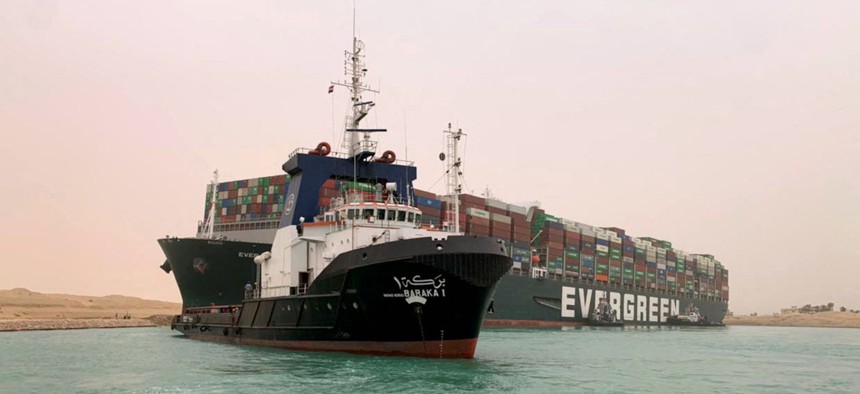
Getty Images
The Suez Grounding Was an Accident. The Next Blocked Chokepoint Might Not Be.
Military planners must bear in mind the tactic of blockships.
The recent spectacle of the hulking container ship wedged into the Suez Canal is a reminder of how vulnerable maritime transportation is to blocked chokepoints. While the Ever Giving appears to have gotten stuck by accident, military planners must remember that such blockages can be inflicted on purpose.
This tactic—called “blockships”—has a long history. British forces used it in both world wars, as did Union forces during the American Civil War. Earlier uses have been documented going back 1,000 years. But this ancient naval maneuver remains highly relevant in the twenty-first century: In 2014, Russian forces used it to trap most of the Ukrainian Navy in a Crimean port. By sinking two obsolete ships to obstruct the harbor exit, they prevented Ukrainian ships from escaping to sea, enabling their capture from the landward side.
In many ports around the globe, ships transit confined waterways that are no wider than the length of a large container ship. An attacker could bribe a crew to deliberately sink one, run it aground, or crash it at a narrow point in the approaches to a port. Alternatively, electronic or cyberattacks against a ship’s control system could cause a channel-blocking accident. Clearing a blockship can take days or weeks, enough time for the other side to make military gains that are difficult to reverse. The trapped ships and submarines are also vulnerable to missile attack, having become a set of fixed targets.
The best way to defend against such an attack is preventing the ship from getting close to the chokepoint, but massive commercial ships go through heavily trafficked waters—including those near military ports—all the time. It may be hard to discern hostile intent until relatively late — and even then, a large commercial ship is hard to stop, regardless of what weapons might be used. The ship that was stuck in the Suez Canal, for example, weighs 200,000 tons. It is as long as the Empire State Building is tall and covers an area greater than 15 football fields. Once such a ship has reached a narrow waterway, it can crash into fixed infrastructure, take aim at another ship, run aground, or scuttle itself by detonating explosives.
Nefarious variations on this tactic could also make the wreck harder to clear. Booby traps or time-delayed explosives could be distributed throughout the ship; detonations would drastically slow every subsequent operation as personnel carefully tried to detect and defuse explosives. A few electronic jammers hidden in the cargo could impede communications of salvage workers and machinery. The ship’s control system could contain malware designed to infect any systems that tap into it. Periodic missile attacks against the responders could further delay clearing the wreck and keep ships trapped in port.
Emerging technologies can make blockship strategies more effective. As a 2013 RAND report noted, unmanned ships can conduct these types of attacks without putting military personnel at risk. The ships need not be technologically sophisticated; any rustbucket of a container ship or obsolete warship will do. It is becoming increasingly viable for even an antiquated ship to operate autonomously: the Office of Naval Research’s Control Architecture for Robotic Agent Command and Sensing, or CARACaS, can be installed to make vessels autonomous at relatively low cost. Alternatively, sensor and video feeds from the ship could be relayed via satellite to enable remote control. (A key issue in this case is that signal jamming could stymie control capabilities. Autonomous vessels, however, would be less vulnerable to that type of counterattack.)
For U.S. military planners, this might be a particularly cost-effective approach to consider: an antiquated ship costing in the low millions of dollars can incapacitate submarines and surface ships costing many times that. Navy planners can readily identify where civilian ship traffic routinely passes close to potential adversaries’ military ports, even as acquisition personnel purchase large, worn-out commercial ships, endow them with CARACaS autonomy kits, and deploy nearby. Reducing the number of enemy submarines to counter, and the size of an enemy’s surface fleet, would enable U.S. naval forces to more easily defeat the rest and to focus on other targets. Another advantage is the potential for plausible deniability, with such pre-war events initially ascribed to an unusual accident.
At the same time, the United States should be wary of potential adversaries using blockships to trap its warships and those of its allies. This is not only a Navy issue: all of the services depend on maritime transport. (The Army famously has more ships than the Navy.) The U.S. military shares many ports and waterways with commercial traffic. To counter the risk of blockships attacks, the DoD services, the U.S. Coast Guard, the intelligence community, and other stakeholders can expand collaboration to identify potential threats based on ships’ navigational behaviors or prior intelligence. The military could consider developing non-lethal weapons that can disable massive commercial ships in order to prevent an attack without creating a navigational hazard elsewhere. The Navy and Coast Guard could also increase collaboration with the private sector to expand capacity to rapidly clear wrecks, and could work with additional partners to do the same in ports overseas.
In recent days, the world saw how one large ship athwart a canal could impose massive costs on world commerce. Russia, likewise, demonstrated in Crimea how an obsolete warship can be. The fragility of maritime lifelines—and the ability to use unmanned ships, electronic warfare, and cyberattacks—may encourage the use of this tactic in future conflict and make it even more effective.
Scott Savitz is a senior engineer at the nonprofit, nonpartisan RAND Corporation.